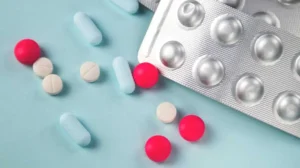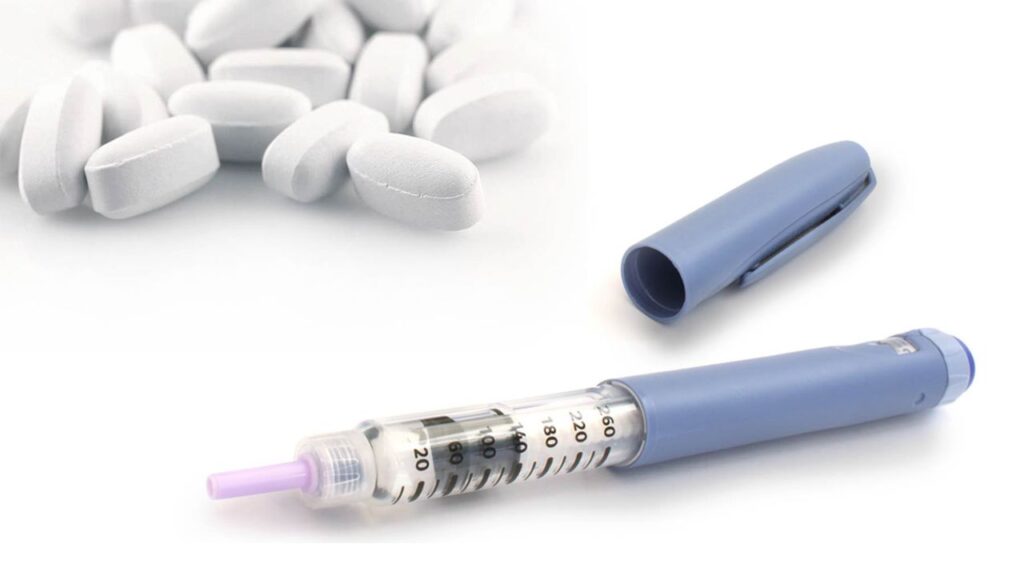Type 2 diabetes is a prevalent condition affecting millions worldwide, characterized by the body’s inability to efficiently use insulin. While insulin therapy is a well-known treatment, various non-insulin medications are available that can effectively manage blood sugar levels. So, this guide explores the landscape of non-insulin diabetes medications, providing insights into how they work, their benefits, and considerations for individuals living with type 2 diabetes.
Contents
What Are The Benefits of Non-Insulin Diabetes Medications?
 Non-insulin diabetes medications offer several benefits for individuals with type 2 diabetes, addressing various aspects of the condition beyond just lowering blood sugar levels. Here’s an overview of the key benefits:
Non-insulin diabetes medications offer several benefits for individuals with type 2 diabetes, addressing various aspects of the condition beyond just lowering blood sugar levels. Here’s an overview of the key benefits:
- Diverse Mechanisms of Action
Unlike insulin, which primarily works by lowering blood glucose levels, non-insulin medications target different physiological processes to manage diabetes. For example, some improve insulin sensitivity, others increase insulin secretion from the pancreas, some reduce glucose production in the liver, and others block the reabsorption of glucose in the kidneys.
- Lower Risk of Hypoglycemia
Many non-insulin medications have a lower risk of causing hypoglycemia (low blood sugar levels) compared to insulin or insulin-stimulating medicines like sulfonylureas. This is particularly important for individuals who struggle with frequent hypoglycemic episodes.
- Weight Management
Some non-insulin medications, such as GLP-1 receptor agonists and SGLT2 inhibitors, can promote weight loss or have a neutral effect on weight. This is beneficial since weight management is a crucial part of managing type 2 diabetes and overall health.
- Cardiovascular Benefits
Recent studies have shown that certain non-insulin diabetes medications not only manage blood sugar but also offer cardiovascular benefits. They can reduce the risk of heart attack, stroke, and cardiovascular death in people with type 2 diabetes who have established cardiovascular disease or are at high risk for it.
- Potential Renal Benefits
Certain medications, such as SGLT2 inhibitors, have been shown to have renal-protective effects, slowing the progression of kidney disease in patients with type 2 diabetes, a common complication of the condition.
By addressing the underlying mechanisms of type 2 diabetes in various ways, non-insulin medications help manage blood sugar levels. Also contributes to the overall health and quality of life of individuals with diabetes.
What Are The Examples Of Non Insulin Diabetes Medications?
 Non-insulin diabetes medications encompass a variety of drugs, each with its mechanism of action and benefits. Here are some key examples categorized by their drug class:
Non-insulin diabetes medications encompass a variety of drugs, each with its mechanism of action and benefits. Here are some key examples categorized by their drug class:
Biguanides (Metformin)
Metformin is the cornerstone of type 2 diabetes management, primarily due to its ability to improve insulin sensitivity and reduce the amount of glucose produced by the liver. Unlike other diabetes medications, metformin does not directly increase insulin secretion. This significantly reduces the risk of hypoglycemia when used alone. It can also aid in weight management, a beneficial side effect for many patients with type 2 diabetes who struggle with obesity.
Sulfonylureas (Glipizide, Glyburide, Glimepiride)
Sulfonylureas are among the oldest classes of diabetes medications and work by directly stimulating the beta cells in the pancreas to release more insulin. This increase in insulin production can effectively lower blood sugar levels but may also increase the risk of hypoglycemia, especially if meals are skipped or delayed. Some newer members of this class have been developed to have a shorter action to reduce this risk. Weight gain is another potential side effect of sulfonylureas.
Thiazolidinediones (TZDs) (Pioglitazone, Rosiglitazone)
TZDs help to improve insulin sensitivity in muscle and fat tissue, allowing the body to use insulin more effectively. They also reduce glucose production in the liver. While effective in lowering blood glucose levels, TZDs have been associated with weight gain, increased risk of heart failure, and bone fractures. Due to these potential side effects, they are often not the first choice for diabetes management but may be considered for certain patients.
Dipeptidyl Peptidase-4 (DPP-4) Inhibitors (Sitagliptin, Saxagliptin, Linagliptin, Alogliptin)
DPP-4 inhibitors work by blocking the action of the enzyme DPP-4, which breaks down incretin hormones. These hormones are released after eating and stimulate insulin production in a glucose-dependent manner, meaning they help increase insulin when blood sugar levels are high but not when they’re normal or low, reducing the risk of hypoglycemia. They have a neutral effect on weight, making them a suitable option for many patients.
Sodium-glucose Cotransporter-2 (SGLT2) Inhibitors (Canagliflozin, Empagliflozin, Dapagliflozin)
SGLT2 inhibitors help lower blood glucose levels by preventing the kidneys from reabsorbing glucose back into the bloodstream, instead promoting the excretion of glucose through urine. These medications have the added benefits of weight loss and blood pressure reduction. However, they may increase the risk of urinary tract and genital infections. Recent studies have shown that they also offer protective effects for the heart and kidneys.
Glucagon-like Peptide-1 (GLP-1) Receptor Agonists (Liraglutide, Semaglutide, Exenatide, Dulaglutide)
GLP-1 receptor agonists mimic the incretin hormones that the body naturally produces after eating to stimulate insulin release in a glucose-dependent manner. Besides lowering blood glucose, these medications slow gastric emptying, promote a feeling of fullness and can lead to significant weight loss. They are administered by injection. And it may be a drawback for some patients. GLP-1 receptor agonists have also been shown to offer cardiovascular benefits.
Alpha-glucosidase Inhibitors (Acarbose, Miglitol)
Alpha-glucosidase inhibitors work by blocking the enzymes in the small intestine that break down complex sugars into simple sugars, thereby slowing carbohydrate absorption after meals. This leads to a more gradual increase in blood glucose levels post-meal. These medications are particularly useful in managing postprandial blood glucose spikes. Gastrointestinal side effects, such as gas and bloating, are common with these drugs.
Meglitinides (Repaglinide, Nateglinide)
Meglitinides stimulate the pancreas to release insulin-like sulfonylureas but act more quickly and for a shorter duration. This makes them effective at controlling blood sugar spikes after meals. They are taken before meals and can be adjusted based on the meal size or if a meal is skipped, offering flexibility in management. However, like sulfonylureas, they carry a risk of hypoglycemia and weight gain.
Each class of medication offers unique benefits and potential side effects. The choice of therapy should be tailored to the individual’s specific health needs.
What Are Some Risks And Considerations Of It?
 While non-insulin diabetes medications provide significant benefits in managing type 2 diabetes, they also come with their own set of risks and considerations. Understanding these potential drawbacks is crucial for optimizing treatment plans and ensuring patient safety. Here’s a closer look at these:
While non-insulin diabetes medications provide significant benefits in managing type 2 diabetes, they also come with their own set of risks and considerations. Understanding these potential drawbacks is crucial for optimizing treatment plans and ensuring patient safety. Here’s a closer look at these:
1. Hypoglycemia
Although less common with some non-insulin medications, certain drugs, especially sulfonylureas, and meglitinides, can significantly increase the risk of hypoglycemia (low blood sugar levels). This can be particularly dangerous if meals are skipped or when these medications are combined with other glucose-lowering drugs.
2. Weight Gain
Some classes of diabetes medications, including sulfonylureas, thiazolidinediones (TZDs), and meglitinides, are associated with weight gain. This can counteract the efforts of weight management, an important aspect of diabetes control.
3. Kidney Function
SGLT2 inhibitors need to be used with caution in patients with impaired kidney function, as their effectiveness is closely tied to the kidneys’ ability to filter glucose. Additionally, these medications carry a risk of causing rare but serious conditions like ketoacidosis, even in patients with normal blood sugar levels.
4. Gastrointestinal Side Effects
Metformin, GLP-1 receptor agonists, and alpha-glucosidase inhibitors can cause gastrointestinal side effects such as nausea, vomiting, diarrhea, and gas. While these symptoms may diminish over time for many patients, they can lead to discontinuation in others.
5. Risk of Infections
SGLT2 inhibitors have been associated with an increased risk of genital and urinary tract infections due to the mechanism of glucose excretion through the urine. Patients need to be aware of the signs of infection and maintain proper hygiene practices.
6. Bone Health
Some studies suggest that long-term use of TZDs can increase the risk of bone fractures, particularly in postmenopausal women. This is attributed to the drugs’ effects on bone density and mineralization.
7. Pancreatitis
Although rare, both DPP-4 inhibitors and GLP-1 receptor agonists have been associated with cases of acute pancreatitis. Patients should be informed about the symptoms of pancreatitis. Thus, seek immediate medical attention if they experience severe abdominal pain.
In light of these risks and considerations, selecting the appropriate diabetes medication is essential. It involves a careful assessment of the individual’s overall health status, personal preferences, and lifestyle.
Conclusion
In conclusion, managing type 2 diabetes involves a comprehensive approach that includes a variety of non-insulin diabetes medications, each offering unique benefits. However, they also carry certain risks. From improving insulin sensitivity and stimulating insulin release to reducing glucose production and absorption, these medications address the complex nature of diabetes in different ways. However, it’s crucial to consider potential side effects.
Working closely with healthcare providers to choose the most suitable medication is key. Do you want to get rid of diabetes? Join our online diabetes treatment program and reverse Diabetes naturally through lifestyle changes such as a Personalized Diet plan, Exercise, Yoga, dieticians, and health coaches.

